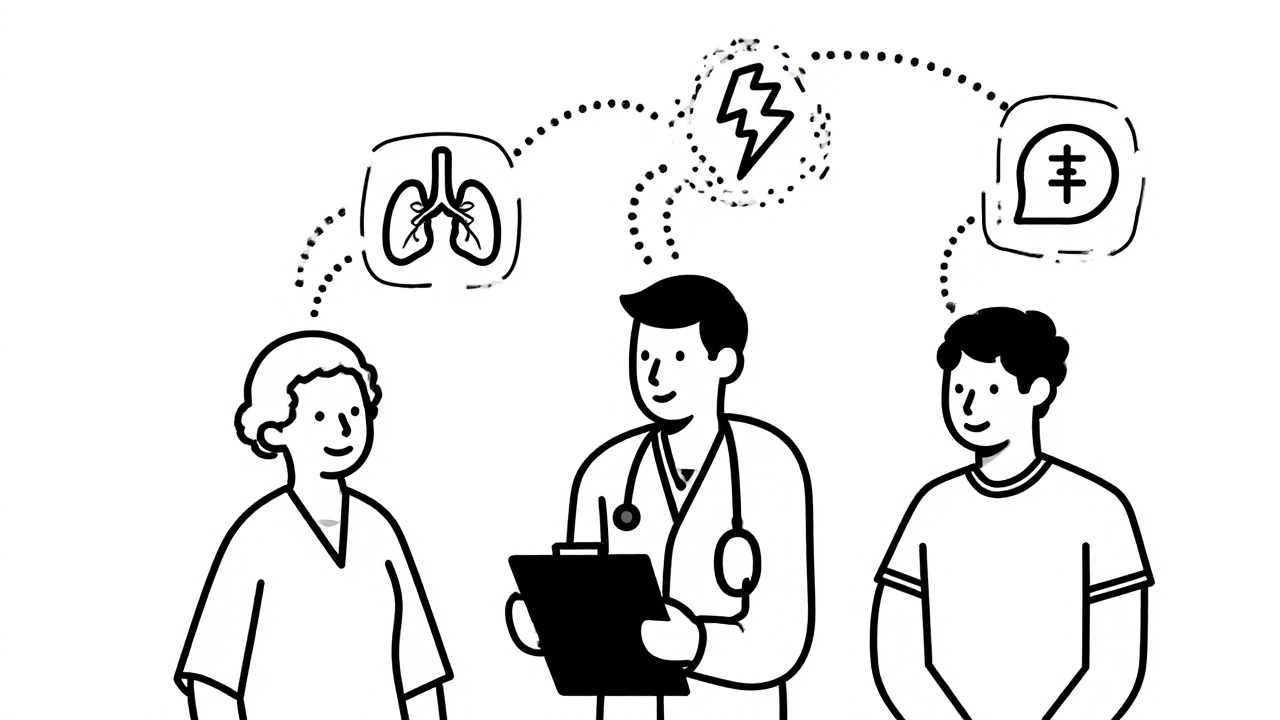
Heart Medication Decision Guide
Select Patient Characteristics
Recommended Medication
Key Considerations
When a doctor prescribes a drug for heart failure or atrial fibrillation, the choice often hinges on the patient’s overall health, other medicines they’re taking, and how quickly they need relief. Digoxin is a classic cardiac glycoside that has been used for more than a century, but newer agents and old‑school alternatives are also on the table. This article breaks down the chemistry, dosing, benefits, and drawbacks of Digoxin and pits it side‑by‑side with the most common alternatives so you can see which option fits a given clinical picture.
What Is Digoxin and How Does It Work?
Digoxin is a natural product extracted from the foxglove plant (Digitalis lanata). It belongs to the cardiac glycoside class, which means it increases the force of heart muscle contraction while slowing the electrical conduction through the atrioventricular (AV) node. The dual effect comes from inhibiting the Na⁺/K⁺‑ATPase pump, leading to a modest rise in intracellular calcium that boosts contractility, and by enhancing vagal tone, which can control rapid heart rhythms.
Because its therapeutic window is narrow-typically 0.5‑2.0 ng/mL-regular blood level checks are recommended, especially in the elderly or patients with kidney impairment.
When Is Digoxin Usually Prescribed?
- Chronic heart failure with reduced ejection fraction (HFrEF) when patients remain symptomatic despite ACE inhibitors, beta‑blockers, and diuretics.
- Atrial fibrillation with rapid ventricular response, particularly when rate control is needed and beta‑blockers or calcium‑channel blockers are contraindicated.
- Patients who need a once‑daily oral medication that can be monitored via serum levels.
Guidelines from the American College of Cardiology (ACC) and the European Society of Cardiology (ESC) now place Digoxin as a secondary option, mainly because newer agents provide more predictable outcomes.
Key Pros and Cons of Digoxin
| Pros | Cons |
|---|---|
| Improves symptoms of fatigue and dyspnea in heart failure. | Narrow therapeutic index; risk of toxicity. |
| Effective rate control for atrial fibrillation without depressing myocardial contractility. | Requires regular serum level monitoring. |
| Oral dosing is simple; once‑daily regimen. | Interactions with many drugs (e.g., amiodarone, quinidine, certain antibiotics). |
| Useful in patients with asthma where beta‑blockers are risky. | Renal clearance; dose adjustment needed in CKD. |
Common Alternatives to Digoxin
Below is a snapshot of four widely used alternatives, each with a different mechanism of action.
- Diltiazem - a non‑dihydropyridine calcium‑channel blocker that slows AV‑node conduction.
- Metoprolol - a β1‑selective blocker that reduces heart rate and myocardial oxygen demand.
- Lisinopril (representative ACE inhibitor) - lowers afterload and improves cardiac remodeling.
- Furosemide - a loop diuretic often paired with other agents to relieve fluid overload.
Side‑by‑Side Comparison Table
| Feature | Digoxin | Diltiazem | Metoprolol | Lisinopril |
|---|---|---|---|---|
| Class | Cardiac glycoside | Non‑DHP calcium‑channel blocker | β1‑selective blocker | ACE inhibitor |
| Primary indication | Heart failure, atrial fibrillation rate control | Atrial fibrillation, hypertension | Hypertension, heart failure, angina | Hypertension, heart failure, post‑MI |
| Onset of action | 4-6 hours (oral) | 30-60 minutes | 1-2 hours | 1 hour |
| Half‑life | 36-48 hours | 3-5 hours | 3-4 hours | 12 hours |
| Key side effects | Arrhythmias, nausea, visual halos | Peripheral edema, constipation | Bradycardia, fatigue, depression | Cough, hyperkalemia, angioedema |
| Renal clearance | Yes (dose adjust) | No | No | No |
| Drug interactions | High (e.g., amiodarone) | Moderate (e.g., CYP3A4 inhibitors) | Low‑moderate | Low |
| Monitoring needed | Serum level, electrolytes | ECG for PR prolongation | Heart rate, blood pressure | Renal function, potassium |
Choosing the Right Agent: Decision Guide
Not every heart patient needs the same drug. Below are practical rules of thumb that help you match a medication to a clinical scenario.
- Renal impairment: If eGFR < 30 mL/min/1.73 m², digoxin dose must be cut dramatically or avoided. ACE inhibitors and beta‑blockers are generally safer.
- Concurrent asthma or COPD: Beta‑blockers can worsen bronchospasm. Digoxin or diltiazem become more attractive options.
- Need for rapid rate control: Diltiazem works within an hour, whereas digoxin may take several hours. In emergencies, clinicians often start with diltiazem or a short‑acting beta‑blocker.
- Risk of electrolyte disturbances: Low potassium or magnesium magnifies digoxin toxicity. If a patient is on loop diuretics like furosemide, monitor electrolytes closely if you keep digoxin.
- Patient adherence concerns: Once‑daily oral digoxin is convenient, but many newer agents also allow once‑daily dosing (e.g., metoprolol succinate, lisinopril). Choose the one with the simplest schedule you’re confident the patient will follow.
Safety Tips and Monitoring Strategies
Regardless of which drug you pick, safety hinges on vigilant monitoring.
- Serum potassium - keep above 4.0 mmol/L when using digoxin; hypokalemia predisposes to toxicity.
- Therapeutic drug monitoring - for digoxin, aim for 0.5‑2.0 ng/mL; check 6‑8 hours after starting or changing dose.
- Electrocardiogram - look for PR‑interval prolongation with diltiazem, QT changes with beta‑blockers, and any new arrhythmias when digoxin levels rise.
- Kidney function - recalc dose of digoxin when creatinine clearance falls; ACE inhibitors also need renal dose adjustments.
- Patient education - ask patients to report visual disturbances (yellow‑green halos) or nausea immediately, as these can signal digoxin overload.

Real‑World Case Illustrations
Case 1 - Elderly patient with HFrEF and CKD: A 78‑year‑old with eGFR 25 mL/min/1.73 m² was on furosemide, lisinopril, and low‑dose metoprolol. Adding digoxin would require a 50 % dose reduction and close monitoring, but the team opted for uptitrating metoprolol instead because of the renal risk.
Case 2 - Young adult with paroxysmal atrial fibrillation: A 34‑year‑old without structural heart disease needed rapid rate control during an episode. Diltiazem IV achieved target ventricular rate in 30 minutes, whereas digoxin would have taken several hours. The patient was prescribed oral diltiazem for future episodes.
Case 3 - Patient with asthma and heart failure: A 55‑year‑old chronic obstructive pulmonary disease (COPD) patient couldn't tolerate beta‑blockers. Digoxin was chosen for its positive inotropy and modest rate‑control effect, with strict electrolyte monitoring.
Bottom Line
Digoxin remains a valuable tool, especially when you need a medication that boosts contractility and slows the heart without major bronchial effects. However, its narrow safety margin, need for serum monitoring, and drug‑interaction profile make newer agents like diltiazem, metoprolol, and ACE inhibitors attractive first‑line choices for many patients. By aligning the drug’s pharmacology with the patient’s comorbidities, renal function, and adherence ability, clinicians can pick the safest, most effective therapy.
Frequently Asked Questions
What is the normal therapeutic range for digoxin?
For most adult patients, the target serum concentration is 0.5‑2.0 ng/mL. In patients with atrial fibrillation, a slightly higher range (0.8‑2.4 ng/mL) may be acceptable.
Can digoxin be used in patients with hypertension alone?
No. Digoxin’s primary benefits are in heart failure and rate control. It does not lower systemic blood pressure, so it’s not a first‑line antihypertensive.
How does digoxin interact with amiodarone?
Amiodarone inhibits the P‑glycoprotein transporter, raising digoxin blood levels by up to 50 %. When the two are used together, the digoxin dose should be reduced and serum levels checked frequently.
Is it safe to take digoxin while pregnant?
Digoxin is classified as pregnancy category C. It can be used when the benefit outweighs the risk, but fetal monitoring and maternal serum level checks are required.
What are the visual symptoms of digoxin toxicity?
Patients may see yellow‑green halos around lights, experience blurred vision, or have a decrease in color perception.




10 Comments
If you look at the pharmacodynamics of digoxin you quickly realize that the drug’s narrow therapeutic index is often treated like a mythic relic rather than a mechanistic tool. The inhibition of the Na⁺/K⁺‑ATPase pump, which raises intracellular calcium, is not some vague concept; it directly translates to positive inotropy that can be lifesaving in select HFrEF patients. Yet the mainstream narrative pushes newer agents because they are “predictable,” forgetting that predictability also comes with its own set of trade‑offs, such as hypotension from aggressive vasodilation. Moreover, the claim that digoxin is only a “secondary option” overlooks its unique advantage in asthmatic patients where β‑blockers pose a real threat. Renal clearance considerations are real, but the dosing algorithms are well‑established and can be personalized; you don’t need a crystal ball, just proper labs. The article’s table nicely lists side effects, but it fails to emphasize that visual halos are an early warning sign, often preceding arrhythmias, which is crucial for patient safety. In the era of polypharmacy, drug‑drug interactions are not a reason to abandon digoxin; they are a reason to be vigilant, especially with amiodarone or quinidine. The point about electrolyte management is spot‑on: low potassium amplifies toxicity, so keeping K⁺ above 4.0 mmol/L is non‑negotiable. While the piece praises the convenience of once‑daily dosing, it glosses over the fact that adherence isn’t just about pill burden; it’s also about patient education, which many clinicians still neglect. The case studies illustrate real‑world scenarios well, but they could have added a vignette where digoxin was the decisive factor in reversing decompensation after diuretics were maximized. Finally, the bottom line that newer agents are “attractive first‑line” is a bit of marketing spin; clinical judgment should always weigh the unique hemodynamic profile digoxin offers against the risk matrix, not the other way around. In short, digoxin is not obsolete; it is a nuanced agent that demands respect, not dismissal.
The safety profile you highlighted is accurate, especially regarding the narrow therapeutic window. Serum level monitoring, combined with vigilant electrolyte checks, mitigates most toxicity concerns. Compared to β‑blockers, digoxin’s lack of negative inotropic effect can be advantageous in select low‑output states. However, the interaction burden does warrant a thorough medication reconciliation before initiation.
From a guideline perspective, the recent ACC/AHA update positions digoxin as a class IIb recommendation for heart failure with reduced ejection fraction when patients remain symptomatic despite optimal therapy. This reflects a balanced view that acknowledges both its historical utility and its limitations in the modern therapeutic armamentarium. The comparative tables adeptly illustrate pharmacokinetic distinctions, yet the narrative could benefit from a more extensive discussion on the role of ivabradine as an alternative rate‑controlling agent in atrial fibrillation. Additionally, the mention of renal dosing adjustments aligns with best practice, but the recommended reduction percentages are not uniformly applied across sources, suggesting the need for clinician‑specific dosing calculators. Overall, the article provides a comprehensive overview, albeit with minor gaps in the exploration of emerging therapies such as SGLT2 inhibitors for heart failure, which have shown synergistic benefits when combined with traditional agents.
Ah, the classic digoxin debate-so elegantly simplified here, yet one cannot help but roll one's eyes at the implicit suggestion that newer drugs are universally superior. While the half‑life of digoxin certainly exceeds that of many contemporary agents, this merely underscores its steady‑state advantage in patients with erratic adherence. One must also consider that the purported "predictable outcomes" of agents like diltiazem are often contingent upon perfect renal function and the absence of concomitant CYP3A4 inhibitors, a scenario rarely encountered in real‑world practice. The article's emphasis on visual halos as a toxicity marker is spot‑on, but it neglects the subtler neuropsychiatric manifestations that can precede ocular symptoms. In sum, the guide offers a solid foundation, though its optimism regarding complete replacement of digoxin seems, frankly, a tad overreaching.
Really great write‑up! i think its importante to remeber that patiens wll benefit from a mix of therapies, not just one drug. digoxin can be a good part of that mix when used wisely. the case examples showed real life usage, which i love. keep sharing these helpful guides!
The optimism expressed is noted; however, the therapeutic nuance of digoxin warrants a more cautious appraisal. While combinatorial approaches are valid, the risk–benefit calculus must be rigorously quantified, especially in polypharmacy contexts. Moreover, the assertion that visual halos are the primary toxicity indicator undervalues the significance of electrocardiographic alterations. A more granular discussion of dosing algorithms would enhance clinical applicability.
It is commendable that the article emphasizes individualized therapy, aligning with contemporary precision‑medicine principles. The thorough comparison of pharmacodynamic properties provides clinicians with valuable decision‑making tools. Moreover, the inclusion of renal function considerations reflects a patient‑centric approach. I would suggest further elaboration on shared decision‑making strategies to bolster patient engagement.
Look, the guide is okay, but it glosses over the fact that many doctors just keep prescribing digoxin because they don’t want to learn new meds. That’s lazy and unsafe. If you’re going to keep it on the shelf, at least give a real protocol for dose titration, not some vague suggestions.
Great synergy overview-digoxin’s inotropic boost truly harnesses cardiac contractility dynamics.
Appreciate the concise summary; it’s always helpful when complex pharmacology is broken down into digestible pieces for the whole community.